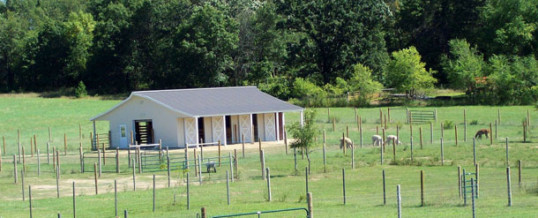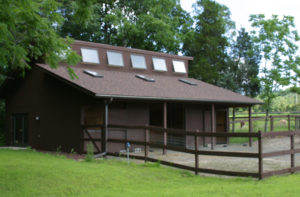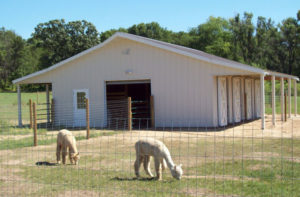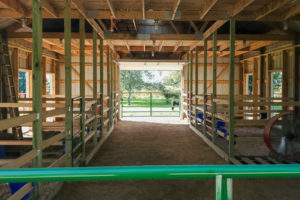
Livestock Buildings and Shelters for Raising Alpacas
Alpacas could be a better choice for your small acreage. Smaller than llamas, these wool producing creatures only need three sided shelters or modest-sized barns and fencing. Add a food source, a bit of patience, a few alpacas. And you’re on your way.
Colorado Alpacas
More people in Colorado are raising alpacas. They are finally catching on after being introduced in the United States in 1984. Today, along the Front Range, a couple dozen commercial alpaca farms have joined the livestock industry. Do you live here? Call us to get barn or shelter details to inform your shopping for livestock alpaca barns.
Alpaca Barns

#311719
Although alpacas can get by in many climates with only a three-sided pole barn, which we also custom design, look at these snazzy barns displayed on the website for Lester Buildings.
Project #311719, a livestock barn built especially for alpaca. This property features a bright and ventilated barn with a unique style designed for an alpaca farm in Pennsylvania. The footprint only takes 30′ x 36′ of space. It features Porges and a 10-foot roof. The colors are White Sand and Antique Brown. Note the wire mesh fortifying the fencing.
Project #119817 in Minnesota is a little bigger with a 30′ x 50′ dimension. This one has a 6/12 pitch roof, a porch, and a place for hay storage. It incorporates DripStop and ridge lite. Those light colors are Pewter Gray and Quaker Gray.
The photo for Project #609366 shows off a series of interior stalls.
Alpaca Disposition
“Between their cartoon faces, fluffy bodies and gentle disposition, what’s not to love about alpacas?” So asks a writer from Home & Garden Magazine.
Much smaller than llamas, alpacas are child friendly, odorless, and charismatic. They’re easy to manage and train. If they do act up its among themselves and are known to spit if their pecking order or food supply gets threatened.

#119817
Alpacas for Income
Alpacas need little space. Some places you can keep up to 10 on 1 acre. Here are a couple of ways to produce income through alpaca farming.
1. Market the offspring to other farmers. Unless you want to put in more work, sell the cria, or young animals. A strong constitution lends itself to easy pregnancy and birth, normally one per year.
2. Sell the lush coat to wool spinners. The fabulous fiber does not contain lanolin and does not need the grease removed before it is spun. The fine textured portion is as luxurious as cashmere.
Check with the Alpaca Fiber Cooperative of North America (AFCNA) to help move the industry into the commercial arena.
Other Advantages
There are other reasons to raise alpacas. Their two-padded toes reduce wear and tear on pastureland. Plus, the manure makes wonderful compost. This makes it easy to get involved with the 4-H club or other projects for the Future Farmers of America. Some people show them or enter parades, too.
Their good health makes them insurable throughout their lifetime. Income tax can be deferred as a herd is growing until the owners sell the offspring.
How to Recognize Alpacas

#609366
If you’re wondering if an animal is a llama or an alpaca, look for these differences.
1. Alpacas weigh anywhere from 100 to 150 pounds. Llamas weigh in at 200 to 350 pounds.
2. Alpacas have fine wool coats and produce more fiber. Llamas have a course outer layer coat over a softer undercoat.
3. Alpacas were bred for their luxurious fiber. They are passive. Breeders developed llamas for carrying loads and guarding.
Contractors – Livestock Buildings
For information about post frame buildings for Farm & Ranch, contact Sapphire Construction, Inc. at (303) 619-7213. custom design and engineer each building to build top quality Lester Building systems to last a lifetime.
AUG
2023

About the Author:
Allen Randa is a second generation Master Carpenter and Owner of Sapphire Construction Inc. Allen personally manages each project from beginning to end. That includes the first meeting, the estimate, the contract and architectural designs.